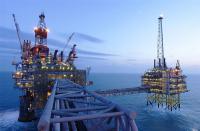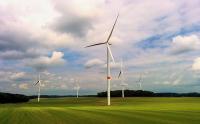-
Studying the impact of removing brine from under- sea carbon dioxide stores

The Birmingham, U.K.-based Energy Technologies Institute (ETI) is seeking partners for a project to study the impact of removing brine from under-sea stores that could be used to store captured carbon. A previous ETI project in its Carbon Capture and Storage (CCS) technology program led to the development of the U.K. principal storage screening database, CO2Stored, which made a number of assumptions to estimate capacity and injectivity for each of the 550 stores off the U.K. coast. One of these was that brine can potentially be removed through a purpose built well or wells from the store to depressurize it, and can still retain the operation and integrity of the store.
-
-
Price of wind energy in U.S. at an all-time low, spurring demand

Wind energy pricing is at an all-time low, according to a new report released by the U.S. Department of Energy. The prices offered by wind projects to utility purchasers averaged under 2.5¢/kWh for projects negotiating contracts in 2014, spurring demand for wind energy.
-
-
Cars to harvest energy from bumps in the road

The 255 million cars on the road in the United States account for 40 percent of the country’s fuel consumption. Most of that fuel is wasted. Engineers may have a partial solution: harvesting energy from the car’s suspension. Only 10 to 16 percent of the fuel a car consumes is actually used to drive — that is, to overcome road resistance and air drag. Most of the rest is lost to heat and other inefficiencies. With clever engineering, however, that deficit can be reduced. Three major opportunities exist for recovering or generating energy while driving: the waste heat given off by the engine, the kinetic energy absorbed during braking, and the vibrational energy dampened by the shock absorbers.
-
-
Where does solar energy stand, where does it need to go to fulfill its potential?
Most experts agree that to have a shot at curbing the worst impacts of climate change, we need to extricate our society from fossil fuels and ramp up our use of renewable energy. The sun’s energy is unlimited, free and clean, and the amount that hits Earth in one hour is equal to the amount of energy used in one year by the entire planet. Yet, although installed global photovoltaic capacity increased almost nine-fold and the price of solar panels dropped by two-thirds between 2008 and 2013, only 1 percent of U.S. and global electricity generation come from solar energy. Where does solar energy stand today, and where does it need to go in order for us to make the transition to renewable energy?
-
-
Integrating renewable and nuclear power plants into the electrical grid
“Electrical grids can work if, and only if, the amount of electricity inserted into the grid from power plants is matched, second by second, to the amount of electricity extracted from the grid by consumers.” If this does not happen there are black-outs. In order to maintain this equilibrium we must focus on two things: demand and supply of electricity into the grid. New research into sustainable energy systems focuses on integrating renewable and nuclear power plants into the electrical grid — a topic high on the agenda for scholars, industry, and policy makers.
-
-
Integrating renewable and nuclear power plants into the electrical grid
“Electrical grids can work if, and only if, the amount of electricity inserted into the grid from power plants is matched, second by second, to the amount of electricity extracted from the grid by consumers.” If this does not happen there are black-outs. In order to maintain this equilibrium we must focus on two things: demand and supply of electricity into the grid. New research into sustainable energy systems focuses on integrating renewable and nuclear power plants into the electrical grid — a topic high on the agenda for scholars, industry, and policy makers.
-
-
Successful test for open-sea pilot connecting power generated from waves, tides, and currents to the grid
Marine and hydrokinetic (MHK) technologies, which generate power from waves, tides, or currents, are at an early but promising stage of development. Many coastal areas in the United States have strong wave and tidal resources, and more than 50 percent of the U.S. population lives within fifty miles of a coastline, making transmission from these resources more economical. With further progress toward commercialization, MHK technologies could make substantial contributions to our nation’s electricity needs.
-
-
Switzerland mulls its energy future
Switzerland has a long history of trying to be as self-sufficient and energy independent as possible. Although its energy supply system has served it well in the past, the country is now looking to turn away from its reliance on nuclear power, at the same time that it is seeking to compensate for the energy lost from hydropower as a result of climate change.
-
-
Oklahoma Supreme Court: Oil companies may be sued for fracking-induced quakes
On 30 June the Oklahoma Supreme Court ruled that oil companies may be sued over quakes if they can be linked to hydraulic shale fracturing methods, or “fracking.” Numerous scientific studies found a direct link between the increase in fracking activity in Oklahoma and the sharp rise in the number of quakes in Oklahoma, a region which until 2009 was considered seismically stable. The number of earthquake in the state has increased from 1.5 tremblors a year before to 2008, to an average of 2.5 a day, according a report from Richard Andrews, the Oklahoma state geologist.
-
-
Producing fuel from Canada oil sands emits 20 percent more CO2 than from U.S. crude
In 2013, the oil industry was producing nearly two million barrels per day from Canadian oil sands. By 2030, that number is expected to rise to just over 4.8 million barrels per day. As the United States takes stock of its greenhouse gas emissions, scientists report that the current oil sands production of fuels from “well-to-wheels” releases about 20 percent more carbon dioxide into the atmosphere than making gasoline and diesel from conventional crudes.
-
-
Rising fossil fuel energy costs risk global food security
Ongoing efforts to feed a growing global population are threatened by rising fossil-fuel energy costs and breakdowns in transportation infrastructure. Without new ways to preserve, store, and transport food products, the likelihood of shortages looms in the future. In an analysis of food preservation and transportation trends, scientists warn that new sustainable technologies will be needed for humanity just to stay even in the arms race against the microorganisms that can rapidly spoil the outputs of the modern food system.
-
-
A new look for nuclear power
Many experts cite nuclear power as a critical component of a low-carbon energy future. Nuclear plants are steady, reliable sources of large amounts of power; they run on inexpensive and abundant fuel; and they emit no carbon dioxide (CO2). A novel nuclear power plant that will float eight or more miles out to sea promises to be safer, cheaper, and easier to deploy than today’s land-based plants.
-
-
Eco-friendly oil spill solution developed
Chemists have developed an eco-friendly biodegradable green “herding” agent that can be used to clean up light crude oil spills on water. Derived from the plant-based small molecule phytol abundant in the marine environment, the new substance would potentially replace chemical herders currently in use.
-
-
Earthquakes in Oklahoma linked to oil, gas drilling
A new study finds that the recent spike in triggered earthquakes in Oklahoma is primarily due to the injection of wastewater produced during oil production. Geophysicists have identified the triggering mechanism responsible for the recent spike of earthquakes in parts of Oklahoma — a crucial first step in eventually stopping them. The study shows that the state’s rising number of earthquakes coincided with dramatic increases in the disposal of salty wastewater into the Arbuckle formation, a 7,000-foot-deep, sedimentary formation under Oklahoma.
-
-
U.S. mid-continent seismic activity linked to high-rate injection wells
A dramatic increase in the rate of earthquakes in the central and eastern U.S. since 2009 is associated with fluid injection wells used in oil and gas development, says a new study. The number of earthquakes associated with injection wells has skyrocketed from a handful per year in the 1970s to more than 650 in 2014. The increase included several damaging quakes in 2011 and 2012 ranging between magnitudes 4.7 and 5.6 in Prague, Oklahoma; Trinidad, Colorado; Timpson, Texas; and Guy, Arkansas. “We saw an enormous increase in earthquakes associated with these high-rate injection wells, especially since 2009, and we think the evidence is convincing that the earthquakes we are seeing near injection sites are induced by oil and gas activity,” says one of the study’s authors.
-
- All
- Regional
- Water
- Biometrics
- Borders/Immig
- Business
- Cybersecurity
- Detection
- Disasters
- Government
- Infrastructure
- International
- Public health
- Public Safety
- Communication interoperabillity
- Emergency services
- Emergency medical services
- Fire
- First response
- IEDs
- Law Enforcement
- Law Enforcement Technology
- Military technology
- Nonlethal weapons
- Nuclear weapons
- Personal protection equipment
- Police
- Notification /alert systems
- Situational awareness
- Weapons systems
- Sci-Tech
- Sector Reports
- Surveillance
- Transportation
Advertising & Marketing: advertise@newswirepubs.com
Editorial: editor@newswirepubs.com
General: info@newswirepubs.com
2010-2011 © News Wire Publications, LLC News Wire Publications, LLC
220 Old Country Road | Suite 200 | Mineola | New York | 11501
Permissions and Policies
Editorial: editor@newswirepubs.com
General: info@newswirepubs.com
2010-2011 © News Wire Publications, LLC News Wire Publications, LLC
220 Old Country Road | Suite 200 | Mineola | New York | 11501
Permissions and Policies
